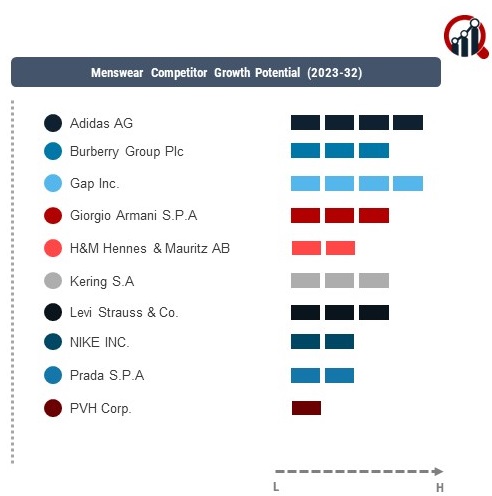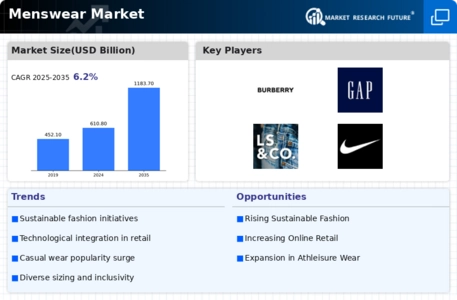Top Industry Leaders in the Menswear Market
 The competitive landscape of the menswear market is shaped by key players implementing various strategies to stay relevant and meet the evolving preferences of male consumers. These players significantly influence industry dynamics, and their strategies collectively shape the overall competitive scenario.
The competitive landscape of the menswear market is shaped by key players implementing various strategies to stay relevant and meet the evolving preferences of male consumers. These players significantly influence industry dynamics, and their strategies collectively shape the overall competitive scenario.
Key Players:
Adidas AG
Burberry Group Plc
Gap Inc
Giorgio Armani S.p.A
H&M Hennes & Mauritz AB
Kering S.A.
Levi Strauss & Co.
Nike Inc.
Prada S.p.A.
PVH Corp.
Ralph Lauren Corporation
Zara S.A. (Industria de Diseño Textil, S.A.)
Strategies Adopted:
The menswear market adopt various strategies to address shifting consumer trends and market dynamics. A common approach involves continuous product innovation, with companies introducing new designs, materials, and styles to cater to diverse fashion preferences. Additionally, strategic collaborations with fashion influencers and designers contribute to expanding brand visibility and maintaining relevance among consumers.
Efficient supply chain management, inventory optimization, and cost-effective manufacturing processes are crucial elements of the strategies adopted by key players. These strategies enable companies to offer competitive pricing while maintaining high-quality products, ensuring customer satisfaction.
Market Share Analysis:
The menswear industry is influenced by several factors. Design aesthetics, pricing, brand loyalty, and the ability to align with changing fashion trends play pivotal roles in consumers' purchasing decisions. Companies that invest in understanding and adapting to consumer preferences gain a competitive edge. Furthermore, effective marketing, robust distribution channels, and an engaging online presence contribute significantly to brand loyalty and market share.
News & Emerging Companies:
The menswear market has witnessed the emergence of new and niche players responding to specific consumer demands and style preferences. Emerging brands, such as Allbirds, Bonobos, and Rhone, have entered the market with a focus on sustainable practices, direct-to-consumer models, and unique product offerings. These new entrants bring fresh perspectives to menswear, contributing to the diversification of available products and enhancing overall market competitiveness.
Industry Trends:
Recent trends in the menswear industry include a growing emphasis on sustainability, e-commerce strategies, and the incorporation of technology. Companies are investing in sustainable sourcing practices, using eco-friendly materials, and adopting ethical manufacturing processes to meet the increasing demand for environmentally conscious products. Additionally, there is a noticeable trend of companies enhancing their online presence, optimizing e-commerce platforms, and leveraging digital marketing to reach a broader audience.
Furthermore, the industry has witnessed increased investments in technology integration. Companies are exploring augmented reality (AR) for virtual try-ons, enhancing the online shopping experience, and incorporating data analytics to understand consumer preferences better. This move not only addresses the evolving needs of tech-savvy consumers but also positions these companies strategically in the competitive online market.
Competitive Scenario:
The menswear market is marked by intense competition among key players, driven by the ever-changing fashion landscape and consumer preferences. Companies are engaged in a continuous race to offer not only innovative and stylish products but also solutions that align with broader trends of sustainability, personalization, and convenience.
The market is also influenced by factors such as changing consumer lifestyles, increased awareness of ethical and sustainable practices, and the ongoing global movement toward conscious consumerism. Manufacturers must adapt swiftly to market demands, ensuring that their menswear not only meets the highest fashion standards but also addresses the evolving concerns of consumers seeking style, comfort, and ethical practices.
Recent Development
The menswear market witnessed a notable development with key players focusing on sustainability initiatives and enhanced digital experiences. Several major companies announced significant investments in sustainable sourcing and manufacturing, incorporating recycled materials into their collections and adopting eco-friendly practices. This move was in response to the growing demand from environmentally conscious consumers who prioritize sustainable fashion.
Moreover, there was a discernible trend of companies prioritizing technology integration to enhance the online shopping experience. Major players announced initiatives to leverage augmented reality (AR) and virtual try-on features, allowing customers to visualize how clothing items would look on them before making a purchase. This move not only addressed the challenges of online shopping but also positioned these companies at the forefront of technological innovation in the menswear market.











